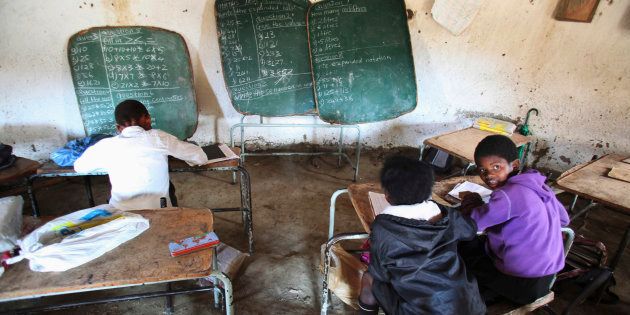
The transformation agenda, especially in basic education, has been the terrain for the ceaseless battle for the implementation of the social contract which was formed sixty years ago on the streets of Kliptown, Soweto - The Freedom Charter. The Charter mandates that the "doors of learning and culture shall be open to all!" The mission of the African National Congress has always been to rid South Africa of the scourge of the apartheid and all its manifestations. Yet, 22 years into our democratic dispensation, many places of learning in the Eastern Cape Province continuously grapple with having to learn under difficult circumstances. Six years after the 1995 White Paper for Education and Training was drafted, the role of quality education was underscored in their vision which states that "education had to overcome the devastation of apartheid, and provide a system of education that builds democracy, human dignity, equality and social justice".
During a two-day summit as far back as 2006, members of the Eastern Cape Department of Education reflected upon transformation in education in that province. Various problems were identified: a shortfall in learners' skills development, in particular literacy and numerical skills; an unequal distribution of resources and infrastructure; and a poor work ethic among educators.
Yet, 10 years after the summit, very little improvements have been made in that sector. This was magnified last week when social media went abuzz from a picture posted by education advocacy group, Equal Education, went viral. The picture depicts a group of schoolchildren from Xhentse Senior Secondary School in Libode in the Eastern Cape, writing their exams outside against a backdrop of the evergreen mountains of the Pondoland. Dispatch Live ran this story last week, captioning the picture as: "over 200 pupils from a rural school in the Libode area share just three small mud classrooms. Some classes are forced to write their exams outside as other classrooms have deteriorated to such a bad state that they now stand the risk of collapsing".
StatsSA, in their 2015 Mid-Year Population Estimates, predicted that the Eastern Cape province would have had a population of 6,916,200 million people at that time, constituting the third largest provincial population after Gauteng and KwaZulu Natal. One of the distinguishing features of this province is that – despite the documented history of missionary education at the beginning of the twentieth century – it still has low literacy levels. This is, to a large extent, due to the apartheid spatial planning that resulted in the inheritance of poor administration capacities in the homelands. While the post-1994 amalgamation was essential for the new South Africa, one cannot downplay the legacies of the patrimonial government and the inequalities it created.
Studies on equity in education conducted by various scholars reveal that inherited economic disparities have affected the quality of education improvement in the Eastern Cape. The most affected are the old Transkei and Ciskei regions. An East-West contrast between the schools and their performances have been identified. The Eastern parts of the province include the coloured areas of Graaff-Reinet, Humansdorp and Willowmore and former white schools in Port Elizabeth, East London, Grahamstown and Queenstown had lower teacher: pupil ratios. On the contrary, the Western side of the province had higher teacher ratios. Such patterns of inequality were also evident in Matric results, where the Eastern schools' pass rates ranged between 50% and 85%, while the Western parts of the province performed at 15% to 40% averages. There is no doubt such disparities are symptomatic of the spatial nature of resource deprivation and apartheid grand plan to create an exclusionary and unequal society.
But why is all of this of significant importance now? Every year, media reports on the poor performance of the Eastern Cape provincial education system and its inability to adequately transform the provincial education into one that is able to meaningfully compete against the other eight provinces. The National Development Plan 2030 vision for education, training and innovation sets out five cross-cutting, interdependent implementable themes, one of which states the need to "lay a solid foundation for a long and healthy life and higher educational and scientific achievement. This relates especially to early childhood development, basic education, further education and training, and higher education". This guiding document further notes that "education institutions must have the capacity to implement policy and, where capacity is lacking, immediate measures need to be taken to address it. The interests of all stakeholders need to be aligned to support the common goal of achieving good educational outcomes that are responsive to community needs and economic development".
November 29 2016 marked the deadline for the Department of Basic Education to implement its Minimum Norms and Standards for School Infrastructure. Times Live, on 30 November 2016, reported that "at least 68 schools have no sanitation facilities and 4,986 have only pit latrines. The government's own National Education Infrastructure Management System said of the more than 23,500 schools in the country, 171 have no water supply and 569 have no electricity". In a Facebook update published by Equal Education, the organisation accuses Minister of Basic Education, Angie Motshekga, the Department and all nine provinces of "wilfully and substantively" missing the 1st deadline of the Uniform Minimum Norms and Standards for School Infrastructure in that they have "failed to eradicate all schools made wholly of mud, wood, metal, and asbestos; and provide all schools with no water, sanitation or electricity, access".
Quality education remains a fundamental pillar in the transformation of a society into one that is just with equal access and opportunities for all. Furthermore, it is a reflection of future prospects essential in strategic, long-term development. It is with the above in mind, that the Mapungubwe Institute for Strategic Reflection (MISTRA) will be hosting a colloquium this week on Systemic Educational Reforms: Lessons from the Eastern Cape.
The aim of this research project is to identify the progress, or lack thereof, made by the Eastern Cape Department of Education in advancing systemic and institutional changes in its provincial structures, districts and within the schools in the province. With the Eastern Cape province used as a case study, this research project seeks to enable various stakeholders, ranging from national and provincial government departments, educational institutes to policy makers, to have a better understanding of how the past twenty years have shaped educational change in South Africa and also to identify lessons that can inform policy and programmes on changing complex educational systems.
